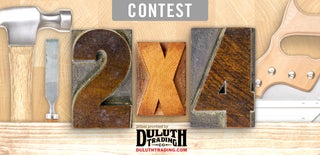Introduction: Elegant Black Glue 2x4 Box
Making stuff with a 2x4 doesn't mean it can't be pretty. The idea behind this project is to make something that has soft curves and a semi-uniform grain look. The video will show you the whole process. Below are some notes from the build.
Milling
When you're choosing your 2x4 make sure you try to find one with the least amount of knots in it. (Sometimes that takes a bit of time :) )
- Square up your 2x4
- Slice it into 1/2" sections
- Rip those sections into 3/4" pieces
Glue-Up
To make the black glue you take some white glue, like Elmer's Glue-All, black water based acrylic paint and mix them together until you get the color you're looking for. As a note, you don't have to worry about the PVA glue not having enough holding power for the project. Theses aren't structural joints and aren't going to be exposed to moisture.
I tried to use wax paper to create a non-stick barrier for the glue....That didn't work. What worked was layers of packing tape on my glue up surface.
Milling the Glued-Up Boards
You'll need to create a flat (or semi-flat) surface on one side of the boards to run them through a thickness planer.
After you've milled the boards to their final thickness you can figure out you cut dimension. This really is determined by how big an interior you want. Once you've got that, you figure out your cuts by
Length = Interior Length You Want + (2 x Material Thickness) + 1/4" SFL
Width = Interior Width You Want + (2 x Material Thickness) + 1/4" SFL
Height = Interior Height You Want
SFL = Some Fudge Length. When I do box joints I add 1/8" to each side so they protrude out a little and either sand or cut them flush.
Cutting the Top and Bottom
Its better to use the assembled sides of the box to figure out the dimensions for the bottom and top. For the bottom, just put the box against your table saw fence and set it so the box touches the teeth of the saw blade. The top needs to be a 1/4" bigger so there is a little overhang. To figure this out I put the box against the fence again, moved it close to the blade and then used a measuring square against the box to add 1/4" (see diagram above)
Shaping the Box
I used an inverted sander held in a vice to add a slight curve to the box sides and top. Doing this gives it the illusion that the box isn't as thick as it is.
Thank You!
Thanks for checking out this post. Most of all I hope you feel like experimenting with how you use what is a pretty common material. This will be entered in the 2x4 challenge, and it would help me out if you voted for it.

Participated in the
2x4 Contest













